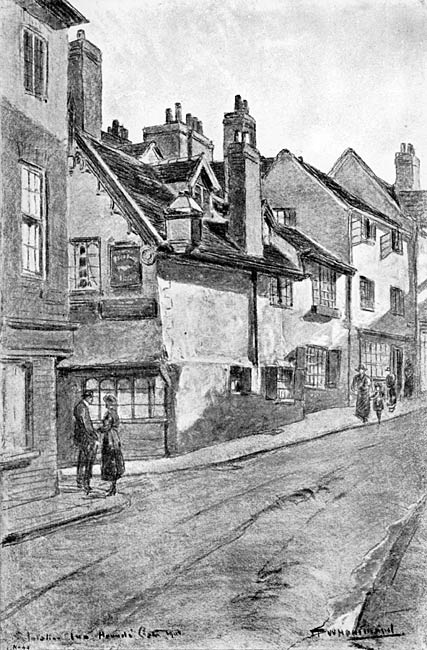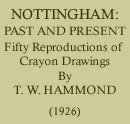< Previous | Contents | Next >
NOTTINGHAM PAST & PRESENT: OLD INNS
THE SALUTATION INN, Hounds Gate, 1911

This ancient inn stands at the corner of Hounds Gate—in which was situated part of the kennels of the Royal Castle of Nottingham—and St. Nicholas Street which in mediaeval times was the Jewish quarter and was called 'Jew Lane'. The 'Salutation' is a half-timbered building covered with stucco, of fifteenth century date—probably contemporary with the setting up at Westminster of Caxton's printing press. The representation of two hands, clasped, on its signboard, gives us the modern interpretation of 'Salutation'; but the salutation originally referred to was that of the Archangel Gabriel to the Blessed Virgin Mary—'Ave Maria plena gratia'. This was an exclamation frequently on the lips of our forefathers, and its use as an inn sign is often an indication of the association of the inn with some religious house : such association in this instance is not proved, but it is a suggestive fact that the Salutation Inn stood half way between the houses of the Carmelite Friars in Friar Lane and the Franciscan Friars in Grey Friar Gate.
The origins of some of our inn signs are very curious—for example: a little lower down Houndsgate we have the 'Elephant and Castle', which was named 'A l'Enfant de Castille', referring to Edward the First's queen, his beloved Eleanor, who died at Harby in 1290 and whose general popularity is attested by the large number of inns bearing this sign.
The whole subject of the inns of Nottingham is very interesting. The Castle, as a royal palace and garrison, was frequently used for meetings of parliament and of councils, and its accommodation was frequently taxed to the uttermost. To prevent discomfort due to overcrowding, certain of the great nobles of the land obtained for themselves houses in the town, which they used for their own residence when summoned to councils. These houses bore the arms of their proprietors, and when unoccupied by their owners, were utilised for purposes of public hospitality. The best known is the 'Talbot', on Long Row, which occupies the site of the inn of the Earl of Shrewsbury, whose badge was the great talbot, or hunting dog.
